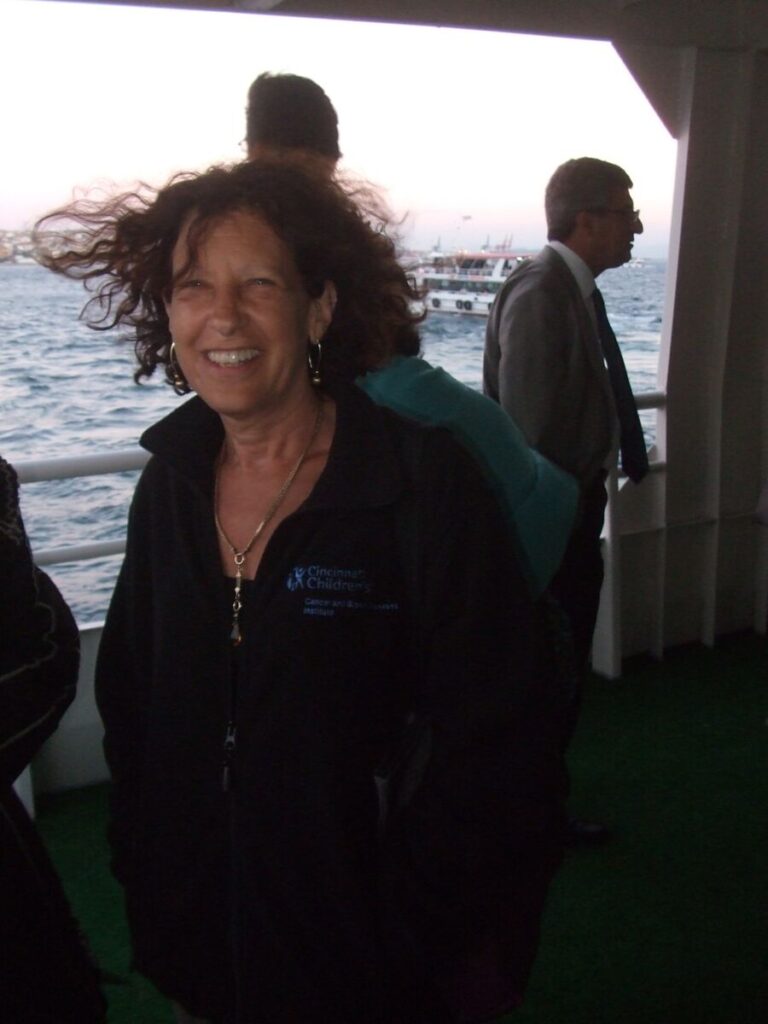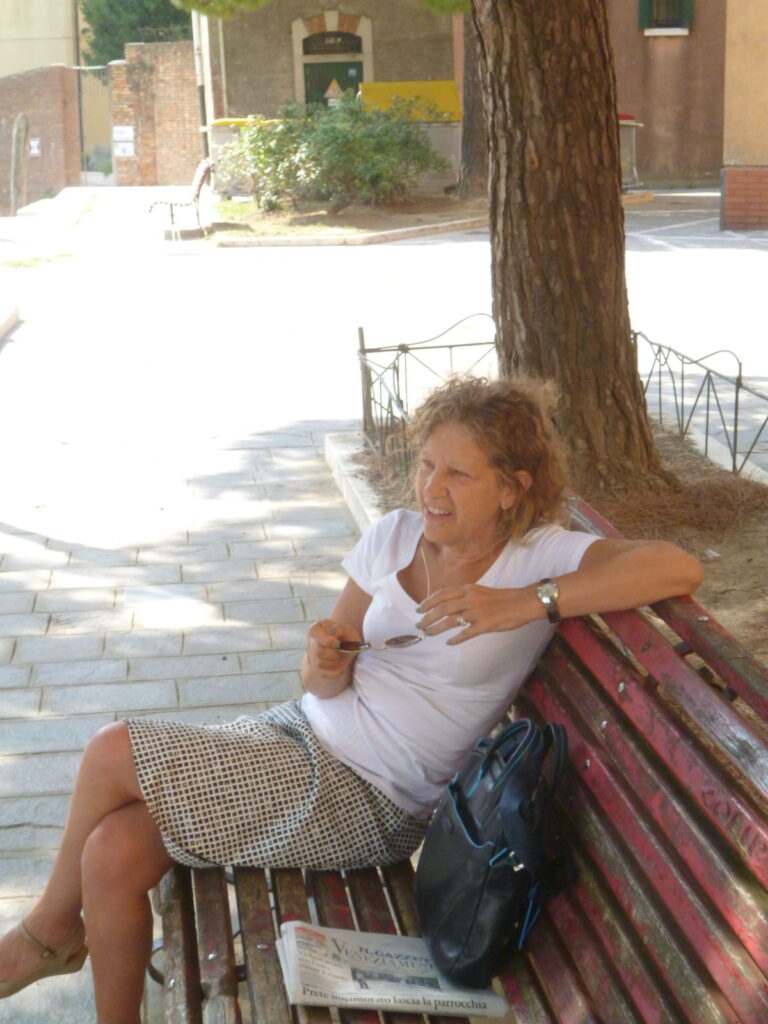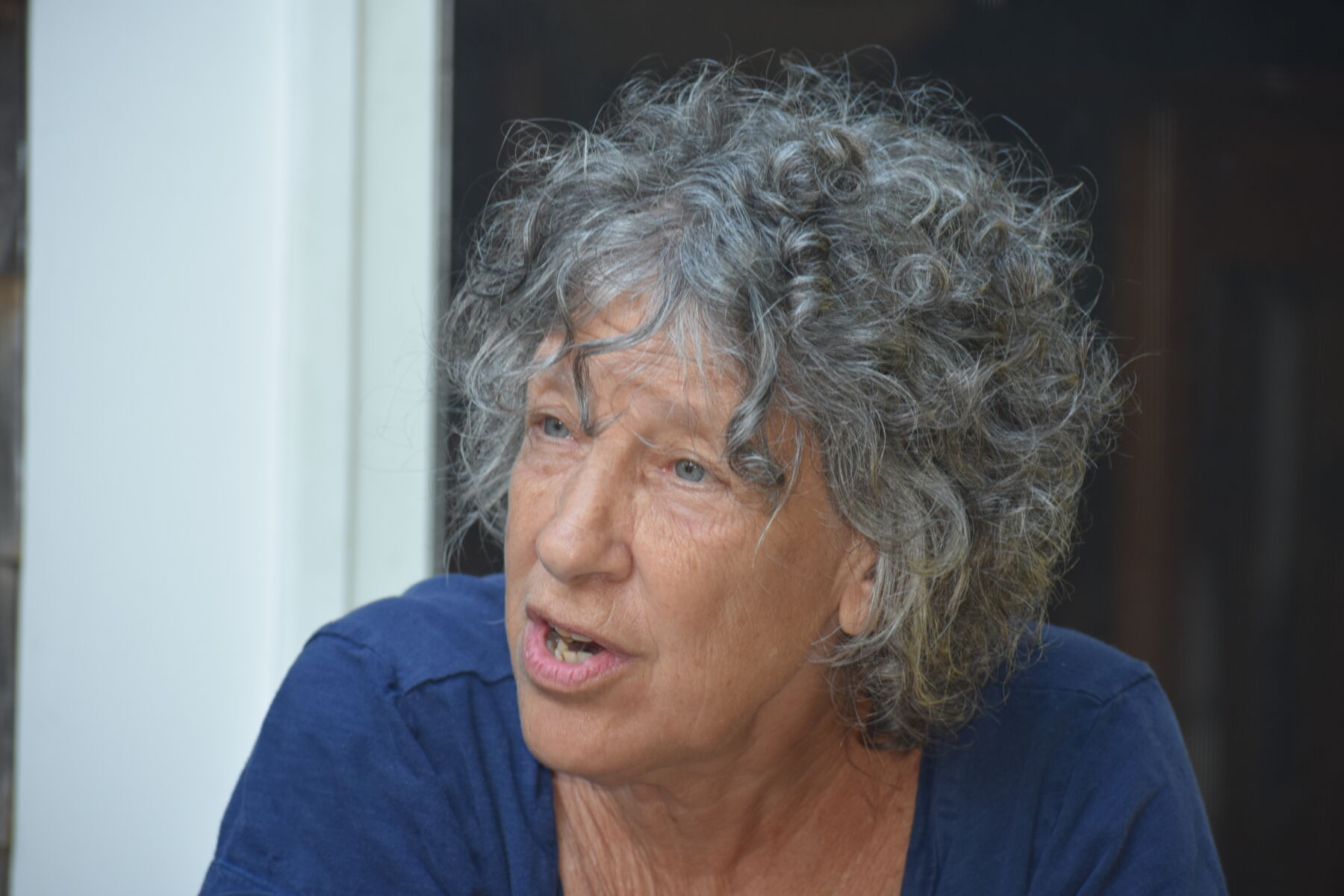Maturing Personally and Professionally: A Lifetime Studying NF1
Nancy Ratner, PhD. Beatrice C. Lampkin Chair in Cancer Biology Professor of Pediatrics, Division of Experimental Hematology and Cancer Biology Cincinnati Children’s Hospital Medical Center University of Cincinnati College of Medicine
Discover more articles in the Women in NF series by clicking here.
I was pregnant with my daughter Sonja in May of 1985 and a postdoctoral fellow at Washington University School of Medicine in St. Louis when I got the news. My mentor, Dick Bunge, was co-chairing a meeting (with Alan Rubenstein and Vic Riccardi) to be held by the National Academy of Sciences in New York City. The topic: Neurofibromatosis. My first thought? Neurofibromatosis? What’s that? Dick went on to ask me to speak about my work on the neuronal mitogen that stimulates Schwann cell proliferation, given that Schwann cells were known to be present in neurofibromas.
By the time I found myself on the enormous stage in NY, I was shaking so much I had to hold the large, heavy pointer I’d been given with two hands. Still, the talks, including a memorable one from Juha Peltonen, who spoke about ECM proteins he isolated from neurofibromas—mainly collagen type I—held my attention. Then, that night at dinner, Alan Rubenstein’s talk focused on NF images through time, starting with wood cuts from the Middle Ages, which I found shocking. Still, as a PhD with no desire to work on disease, I returned home where I loved, and was content with, my tiny cultures of neurons, Schwann cells, and microscopes.
It was the next year, upon receiving notification from the National Neurofibromatosis Foundation (NNFF) of their hope to support postdoctoral fellows to work on NF1, that the idea struck me: What if neurofibromas contained Schwann cell mitogen that I could identify? I ran my application by Dick, wondering if I should send it. “It’s a hypothesis,” he said, “and this disease needs all the hypotheses it can get.” When my application was funded—notification came by telegram, that’s how long ago this was—I couldn’t believe it. When it was followed up with a check made out to me, Nancy Ratner, for $25,000, it took a while to believe it was real. My first response was, Mexico, here I come! Fortunately, pragmatism prevailed and I brought the check to the business office instead.
A year went by. I’d just taken a faculty position in Cincinnati, and the NNFF let me bring the grant purchases with me, a teaching microscope for my new lab and a marble table. In my new windowless lab, I proceeded to grind up neurofibromas and identify two major growth/angiogenic factors in those tumors: Hepatocyte Growth Factor (HGF) and Fibroblast Growth Factor 2 (bFGF). We also found that it was the Schwann cells, not the fibroblasts, isolated from neurofibromas that showed characteristics defined as tumor cell characteristics. In those early years, we depended on tumors most often provided by Vic Riccardi (who also once set a leg from an NF autopsy) and by Alvin Crawford, a saxophone-playing orthopedic surgeon at Cincinnati with a profound interest in NF. We couldn’t have done anything without both these folks.
Soon after, my interest in Schwann cells led to invitations to tiny NF meetings at various institutions where we discussed progress in identifying and then cloning the NF1 gene. With first 30, then perhaps 50, people in the audience the meetings were intimate, focused, and exciting. I was a cell biologist introduced to genetics. As a neurochemist/cell biologist/developmental neuroscientist, it was invigorating to be exposed to new ideas and to be able to provide a different viewpoint to geneticists. It was at those meetings that I first met career-long colleagues, then postdocs, and learned to admire lab leaders like Francis Collins and Ray White, and learned how valuable it was (for me and them) when the leaders invited junior colleagues to join in the experience. The field was so small! No one knew anything! Which cell was the main culprit in NF? What was the NF1 gene like? How did the protein work? These were the questions we wanted to answer. No one was yet thinking about the potential for a treatment, much less a cure for NF. Remarkably, some of these questions remain still partially unanswered in 2024.
I then received an invitation to serve on the NNFF research advisory board to review postdoctoral grant applications, my first time on a grant review panel. After several days reviewing each grant and reading extensively to understand each one, I think the panel was a bit dumbfounded by my overpreparation, based on my naiveté and lack of mentorship experience—admittedly, mostly, due to my sheer panic that I would appear a fraud. I still remember Peggy Wallace’s grant! The leaders of the NNFF were guided by top scientists in related fields, which allowed them to guide the foundation and set priorities: To put research first. Among other things, that meant that the level of reviewers (apart from me) were senior scientists, world class. It was that tenet that set the foundation in those years on the path of identifying and supporting excellence. NNFF made me feel part of something larger than myself and feel that I was a contributor. Being part of a community outside my home institution enriched my career then, and continues to do so now.
Our NF meetings continued. We watched the cloning of NF1 (when Peggy Wallace called me to say the Science paper was coming out) and, later, the cloning of NF2. Our lab made NF1 antibodies that emphasized the remarkable differences in expression patterns among cell types and over developmental time. We identified astrogliosis, first in brains from NF1 patients (because one of my MDPhD students, Mike Nordlund, wanted to attend at autopsies and help retrieve valuable specimens) and then in a mouse model.
Our work with Neal Copeland and Camilla Brannan on the mouse model came from meeting Neal at an NF1 meeting. Later, he called and asked if we could use our antibodies to have a look at NF1 expression in his mice. In order to maintain the NF1 mouse colony, I went down to a lab in Cincinnati to learn to do PCR and genotype. Neal was so clear at the outset: My team would be authors on his paper describing the mice, and his team would be authors on our first subsequent paper. A true team player and colleague!
Neal, it turns out, also changed my life on a bus one day when he told me that he and Nancy Jenkins, his wife and lab partner, had never gone to a meeting without booking a meal or museum or event so they’d experience the towns they visited. I took Neal’s advice to heart, yet it was due to my husband Arthur’s willingness to construct his career as a musician and engineer around mine that I was able to work and travel while he remained at home base to enable our family life. Without such a supportive spouse, having kids and doing science would have been nearly impossible for me (Thanks, Arthur!). Alone, and together, we have had adventures all over the world (Thanks, European NF!).
Meeting strong women, especially clinicians, has been an immeasurable factor in my growth and experience. Women like Sue Huson, Ros Ferner, Meena Uphadyaya, and Dusica Babovic, whose voices in meetings were heard, never talked over. Their acceptance in the community made it so much easier for women to rise up in the consortium. Long afternoons free at NNFF meetings also allowed for things like hiking in Aspen led to collaborations, such as one with Brigitte Widemann and Eva Dombi, which last to this day.
The identification of NF1 as a RAS-GAP revolutionized the field and, of course, in a smaller way, my lab. When Larry Sherman and Haesun Kim were in the lab, Larry showed, through a novel immunostaining assay he developed, that Ras-GTP was active in Schwann cells, not fibroblasts. Haesun learned to culture mouse Schwann cells and was able to show that the Nf1 mutant Schwann cells secreted angiogenic factors and had elevated RAS-GTP and, intriguingly, that heterozygous cells, not just cells completely lacking NF1, showed a phenotype. Ultimately, the finding that Nf1 heterozygosity causes effects has been verified in many types of cells (T cells, mast cells, etc.) by many, many key groups in the NF community.
When I think back to those early years, I am grateful to the very strong mentors who supported me, including Peter Bellerman (head of the NNFF), Dick Bunge (my postdoc mentor) and Francis Collins (a member of the NF Consortium, who always listened without bias relative to gender, and always criticized strongly and clearly, yet kindly—“Where are the controls?”).
A milestone in my career was moving to Cincinnati Children’s Hospital’s division of Experimental Hematology and Cancer Biology, which was expanding and thriving under the fabulous mentorship of Dave Williams. My goal was to help develop a new Neuro-oncology research program. My contribution included cheerleading recruitment of a cohort of clinicians and spearheading recruiting investigators interested in brain tumors and in NF1 to complement the wonderful NF1 genetics clinic started by Betty Schorry. Our clinical and research programs have remarkable strength and working with this team has been memorably invigorating and fun.
A terrific postdoc came to my lab in the form of Shyra Miller, originally from a small town near Cincinnati, who’d received her PhD in North Carolina. It was my great fortune that her wish to rejoin her family coincided with my lab’s desire for someone with her knowledge of genetics and her ability. Shyra’s push to start working with microarrays to study gene expression in NF led to the microarray consortium we developed. Putting together a group from inside and outside the field, and then seeing the project yield data that would be used for many years, was such a rewarding experience. Collaborations with Peggy Wallace, Anat Stemmer-Rachammimov, Meena Uphadyaya, Conxi Lazaro, and Edu Serra enabled human cell and tissue acquisition to go along with the mouse cells and tissues that Marco Giovannini and I provided. Again, the life-long friendships developed within these collaborations make thinking of them warm my heart. Shyra, who held the group together and did all the organizational heavy lifting, ultimately left NF—and research—for family reasons, but again, a lifetime friendship remains. So much so that we wrote papers together for years after she left the lab (even if our ulterior motive was to keep in touch!).
Spurred on by my experience with the microarray consortium, during the brief time the NIH supported program project grants in NF1, I brought together a group to write one. Needing someone doing something technically novel, I immediately called Dave Largaespada, who had developed the Sleeping Beauty Transposon system for use in mice to ask if he’d want to use that technology in NF. Excited, Dave agreed, and it was his component, I believe, that got the grant-funded. The work with Tim Cripe, an expert in xenografts and drug testing, was also critical. Beyond the papers, though, the more profound outcome of that work has been longer-term collaborations with Tim and Dave. My collaboration with the Largaespada lab has lasted for two decades, enriching my lab and his, with cross-disciplinary monthly conference calls over the course of all 20 years. Indeed, our annual co-lab meetings (sadly abandoned after COVID) became personal interactions that included many students and postdocs, perhaps most notably Eric Rahrmann, who has just started his own lab in Minnesota.
The NNFF (by this time called the Children’s Tumor Foundation) continued to operate at a world-class level. One day the announcement came that applications would be considered for a group, a Preclinical Testing Consortium, to test drugs in NF models. Jianqiang Wu of my lab had made a robust mouse model of neurofibromas in NF1 that we had been using to try to test drugs in a small way. Unsure that I should apply, George Thomas, a collaborator at the time, simply said, “Of course you should!” Armed now with the impetus (encouragement) I needed, my request for Jianqiang to work with me was met with enthusiasm—I knew that this was a project I couldn’t do alone. When I applied to be part of the preclinical consortium, I never dreamed it would change my career and life, and that Jianqiang and I would still be partners in that enterprise in 2024.
Karen Cichowski, Kevin Shannon, and I stuck it out (with others in and out over the years) in the Preclinical Consortium. I learned so much from mentorship from Pharma and Biotech, notably what PK and PD were and how to do a proper “industry standard” preclinical trial. Funding from charitable donations completely enabled that effort, changing the field. Our finding that MEK inhibitor could shrink neurofibromas was a complete surprise. Until that point, it was unclear anything could shrink a tumor with so much matrix in it! It has been humbling to watch clinicians take preclinical data, have the patience to mount and carry out clinical trials, and ultimately see the first approval of a MEK inhibitor by the FDA.
Jianqiang Wu regularly informs me that I can’t retire until I cure NF. To that end, and with an eye toward making it even more fun, over the years I’ve recruited a group of investigators with a keen shared interest in NF1 and, now, RASopathies. Working locally every day with Elliott Robinson, Ron Waclaw, and Jinqiang Wu makes going to work a true pleasure, with the only major regret that I’ve never managed to recruit a woman faculty member. The folks in my lab are diverse and hardworking, doing seemingly better science than ever before. Hopefully, several papers will be published soon. It might go without saying, but science is a team sport and all my students, fellows, and technical staff are like a family to me…squabbling sometimes, but always committed and in the pursuit of truth.
So, what are we doing and hoping for in the years to come? I want nothing more than to keep doing science.
In the past 10 years or so, we have been spurred to study the immune cells in neurofibromas. How we could have been blind to all those immune cells in neurofibromas prior to Carlos Prada’s arrival in the lab as a fellow is difficult to say. Nonetheless, now we have tools and postdocs to study the T cells, DC, and macrophages that make up more than a third of the cells in neurofibromas. Still, though, the Schwann cells are the main culprits; it is the Schwann cells that recruit the immune cells. For that reason, the rest of my lab still works on Schwann cells, hoping to identify what kills tumor Schwann cells and prevents or cures neurofibromas. As time never seems enough, I am more and more inspired to tackle some additional remaining questions in NF: What are the NF1 modifier genes? Where is NF1 in Schwann cells and with what does NF1 interact?
Overall, my life has been entwined with the NF community. Arthur and I have raised two fun, kind children, Alex and Sonja, each happily married (to Rae and Ezequiel respectively), with whom we’ve shared life and summers at Woods Hole. Thankfully, they willingly agree to hang out with us and have not resented (I have asked) my dedication to science. Sonja now has three children of her own. Perhaps one of them will have scientific inclinations and be able to enjoy the excitement of discovery and the pleasure of community that working in NF has bestowed on me.




